This easy recipe for Rabdi results in a decadent Indian dessert that combines the richness of sweet thickened milk with the velvety texture of paneer. Flavored with saffron and cardamom, and adorned with pistachios, this 25-minute Indian sweet is a must-have during festivals or celebrations.
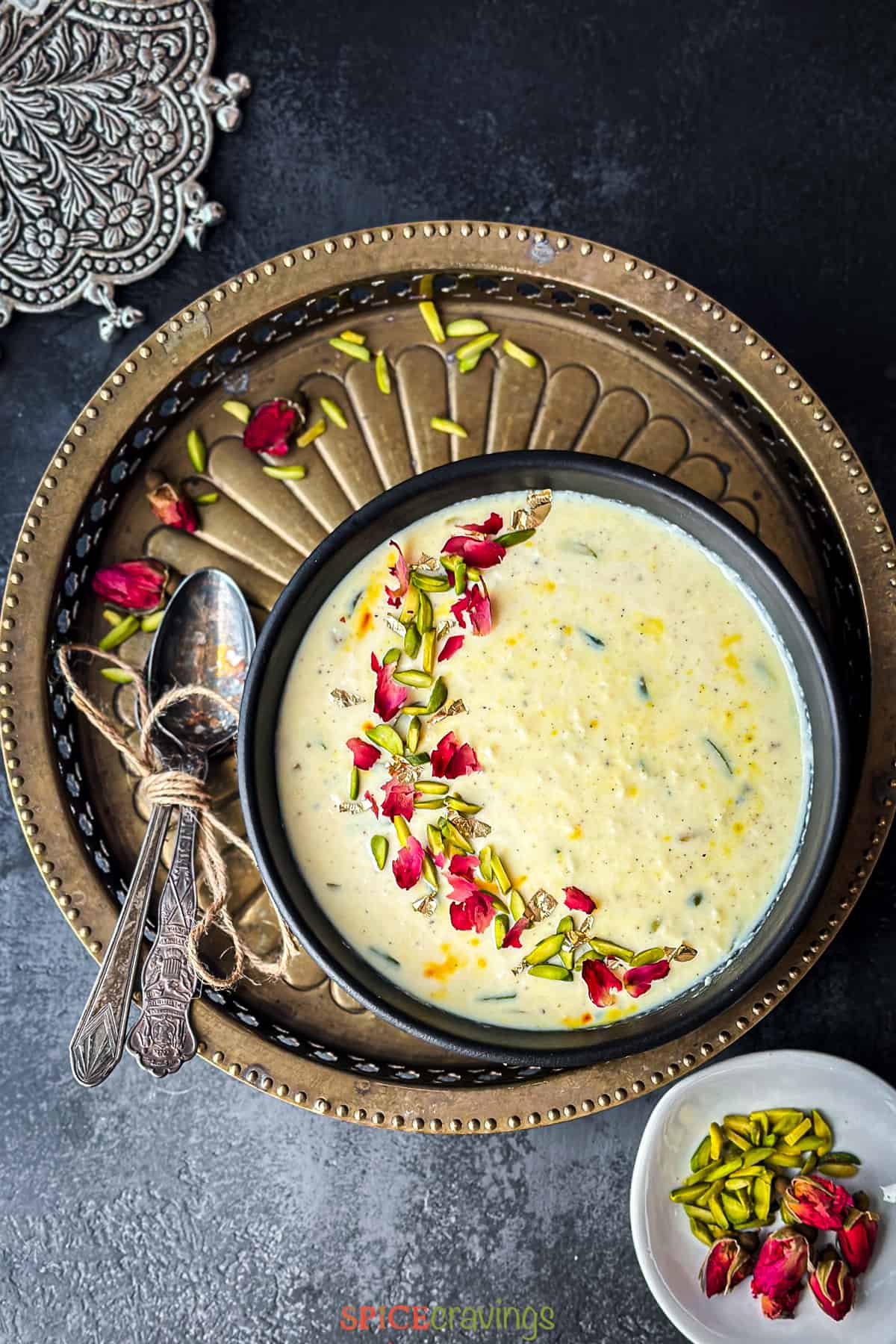
Jump to:
What is Rabdi?
Rabdi, also known as Rabri, is a traditional Indian dessert made by reducing and thickening milk through a low and slow simmering process. It's a rich and creamy sweet dish known for its luscious texture and delicate flavor.
Why You'll Love This Recipe
My quick and easy twist on this classic dish provides an Instant rabdi recipe that takes the traditional dessert to a new level of decadence and reduces the cooking time and effort considerably.
I incorporate paneer into the milk, which not only adds a creamy consistency but also infuses a subtle, milky sweetness. The best part is that it also adds protein to this dessert, thereby making it more balanced.
With its harmonious blend of aromatic flavors and luxurious texture, this paneer rabdi is sure to captivate your taste buds and earn you compliments. Let's get started on this exquisite recipe!
Ingredients - Notes & Substitutions
It takes a handful of good quality ingredients to make delicious rabdis at home. Here's what we need:
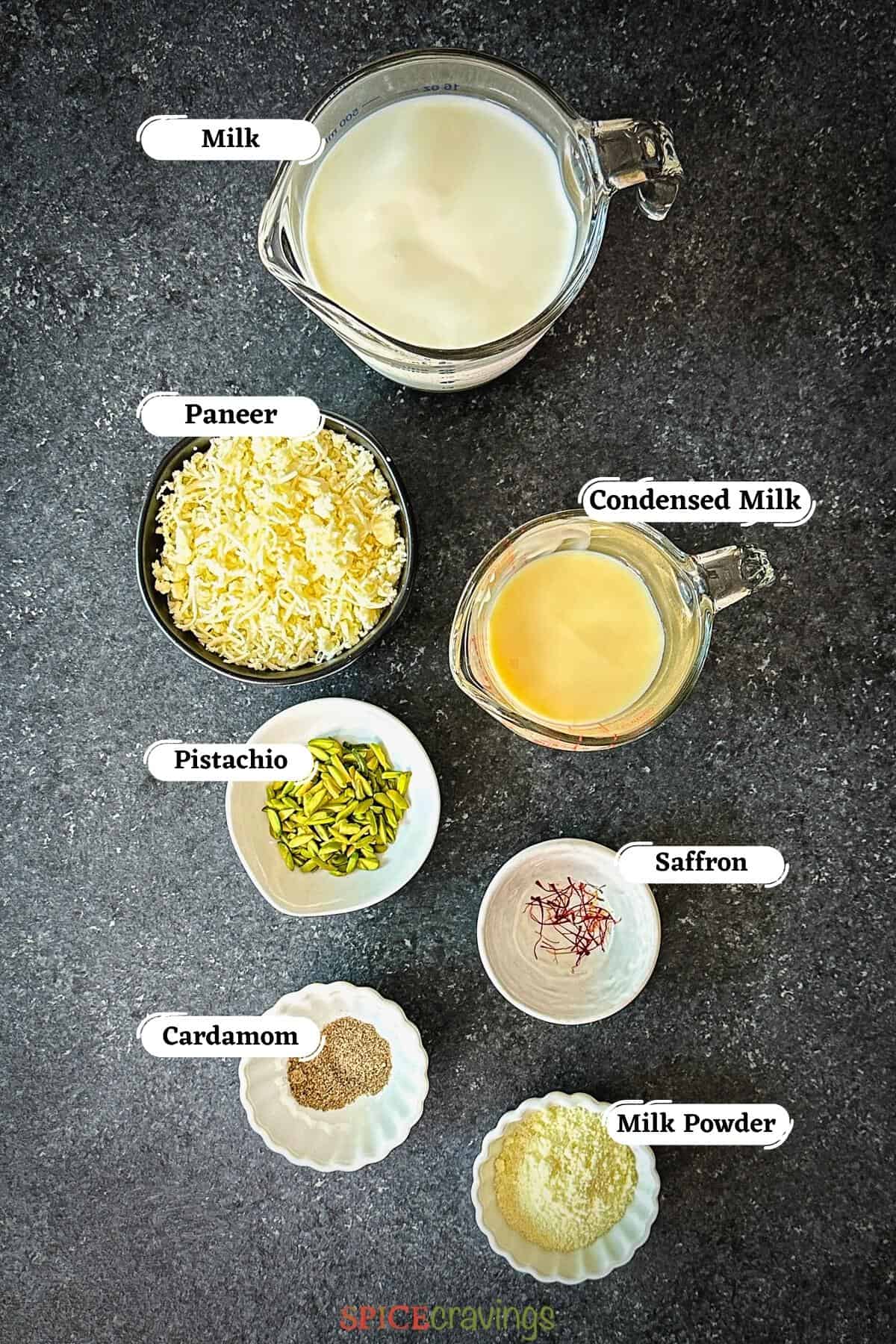
- Paneer: This firm Indian cottage cheese has a mild, creamy flavor. I usually prepare it at home with full-fat milk using this easy recipe or buy a good quality paneer from my local Indian store or Whole Foods. Full-fat paneer is key for a rich and creamy result.
- Milk: Milk, a staple ingredient in rabdi, serves as the base, providing richness and creaminess to this traditional Indian sweet. Use whole milk for the best flavor.
- Condensed Milk: This not only adds sweetness but also adds creaminess while providing the iconic silky texture to this dish.
- Milk Powder: This enhances the thickness and richness of rabdi, adding a concentrated dairy flavor to the dessert. Use a good quality full-fat brand.
- Saffron: Saffron imparts a beautiful aroma and yellow hue to the rabdi. Soak it in warm milk to extract those flavors.
- Cardamom Powder: This adds a pleasant floral flavor to the dish. For the best flavor, make your own powder by grinding the seeds from 2 green cardamoms. Or use a good quality brand from the store.
- Pistachios: Pistachios are the traditional choice for rabdi and are used while cooking as well as for garnish. They provide a delightful crunch in contrast with the creamy rabdi. Feel free to substitute them with sliced almonds, or skip them altogether for a nut-free dessert.
- Edible Rose Petals: Edible rose petals are used as a decorative and fragrant finishing touch for rabdi, adding a touch of elegance and a subtle floral note to the dessert. This ingredient is optional though.
Scroll to the recipe card for a detailed list of ingredients and quantities.
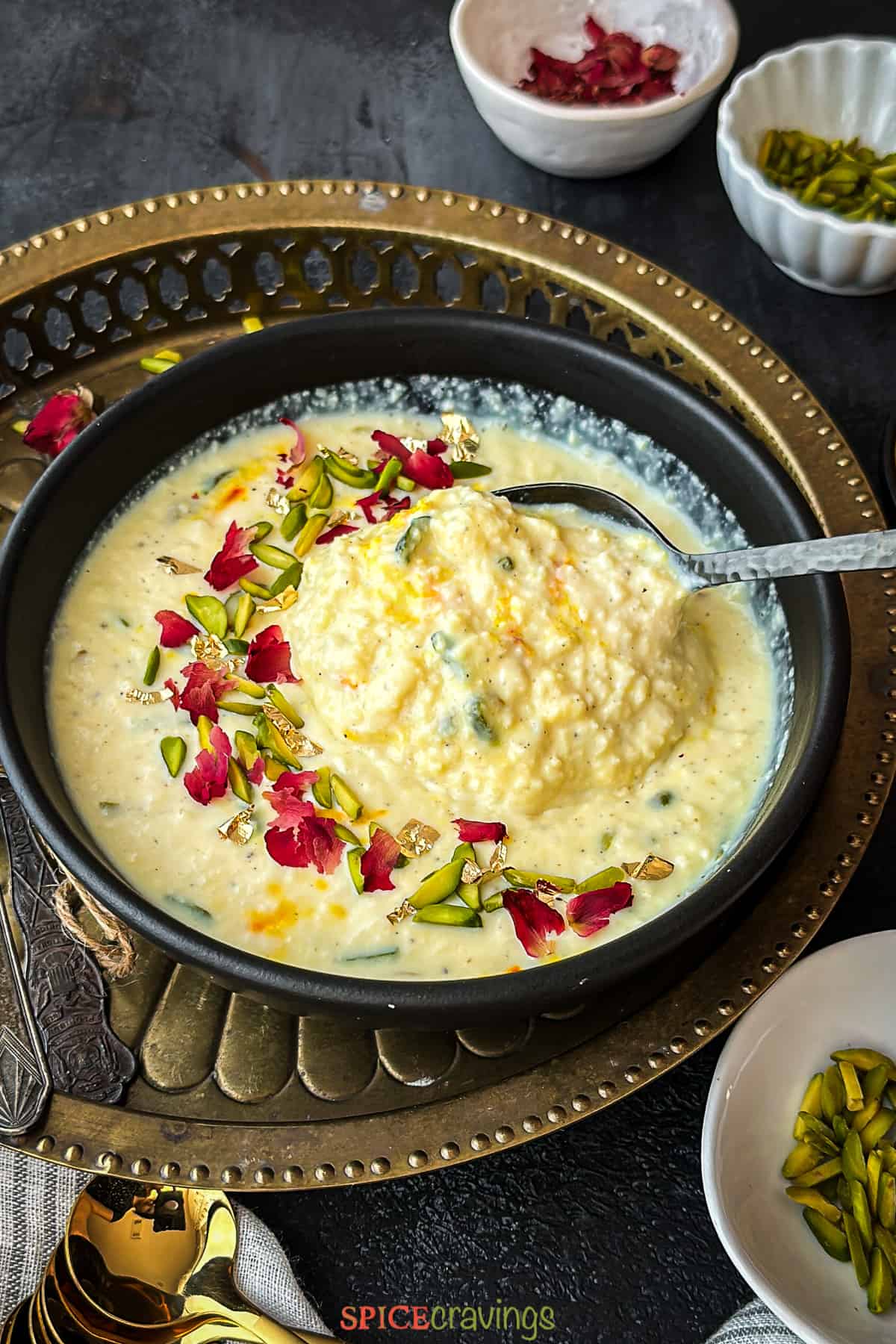
How To Make Rabdi
Here are the step-by-step instructions and photos on how to make instant rabdi that will wow your guests:
Add water: Place a deep non-stick pan and turn on the heat to medium-high. Add water to the pan. This prevents the milk from sticking to the pan.
Boil milk: Add milk to the pan and bring it to a boil, stirring regularly while scraping the sides of the pan with a spatula. (pic 1)
Soak saffron & simmer milk: When the milk reaches a boil, reduce the heat to medium. Scoop out 2 tablespoons of the warm milk and add to the saffron. Let it sit for 5 minutes for the saffron strands to release their color. Keep simmering the milk for 5 minutes, stirring every minute and scraping the sides. (pic 2)
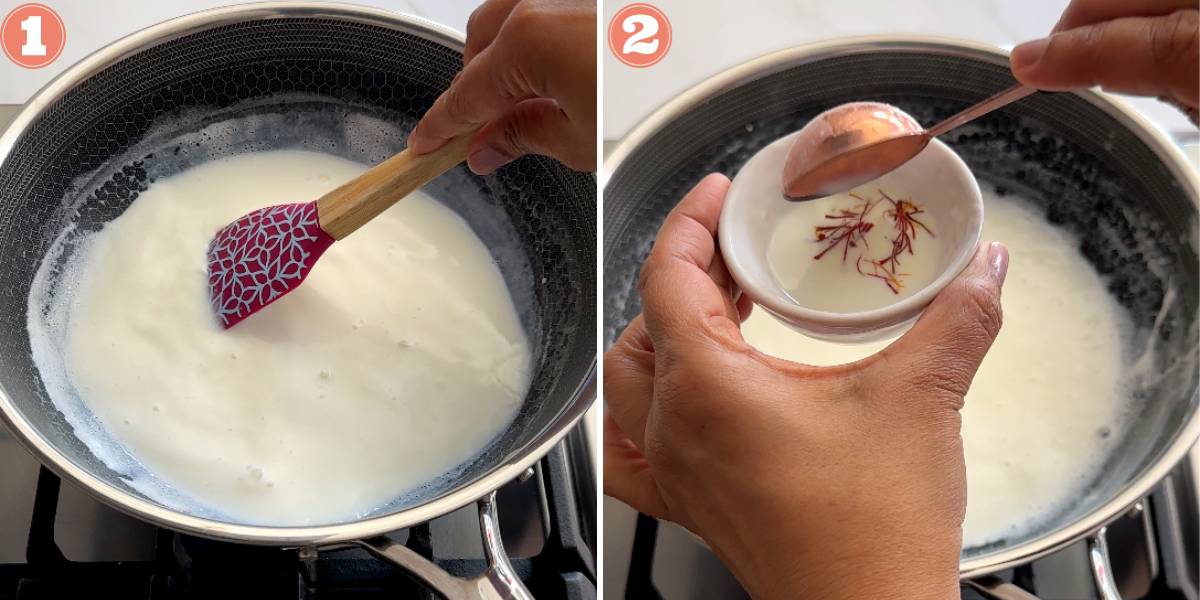
Add rabdi ingredients: Now add grated paneer, condensed milk, soaked saffron with milk, milk powder, cardamom powder, and sliced pistachio to the simmering milk, and stir well. (Pic 3 & 4)
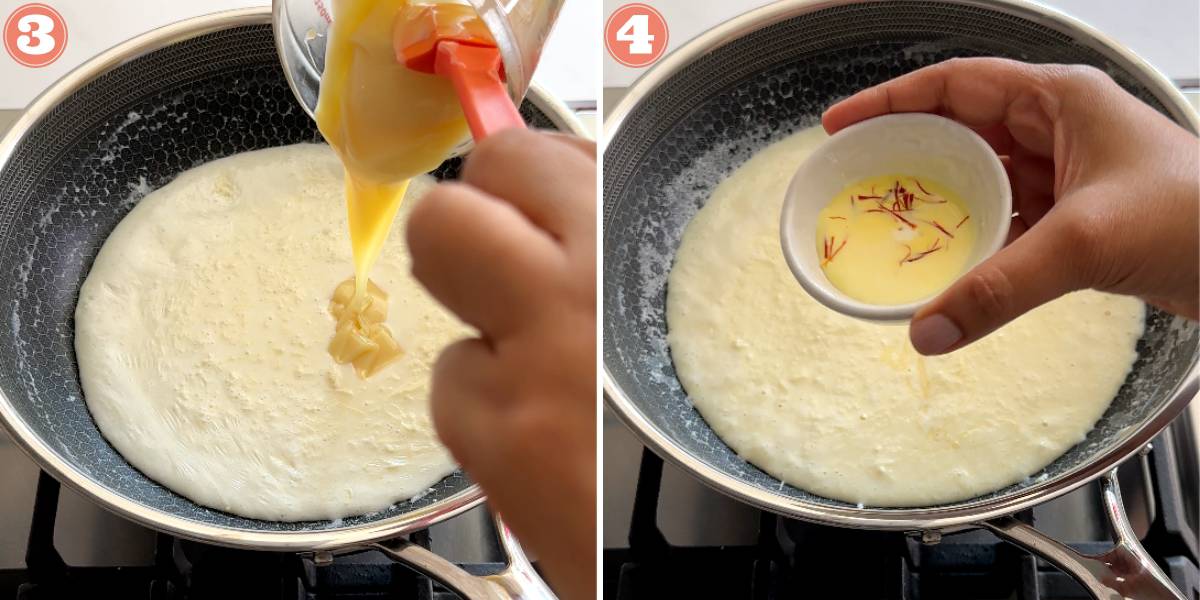
Simmer to thicken: Continue to simmer the radbi mixture on medium heat until it begins to thicken, about 10 minutes. Stir and scrape the sides regularly during this time. The rabdi should resemble the consistency of heavy cream at this point- thick but still pourable. Keep in mind that it will thicken considerably as it cools, so don't overcook it.
Chill and serve: Pour it into a serving bowl and refrigerate to chill for 4 to 6 hours. Serve it as it is, or pair it with a jalebi.
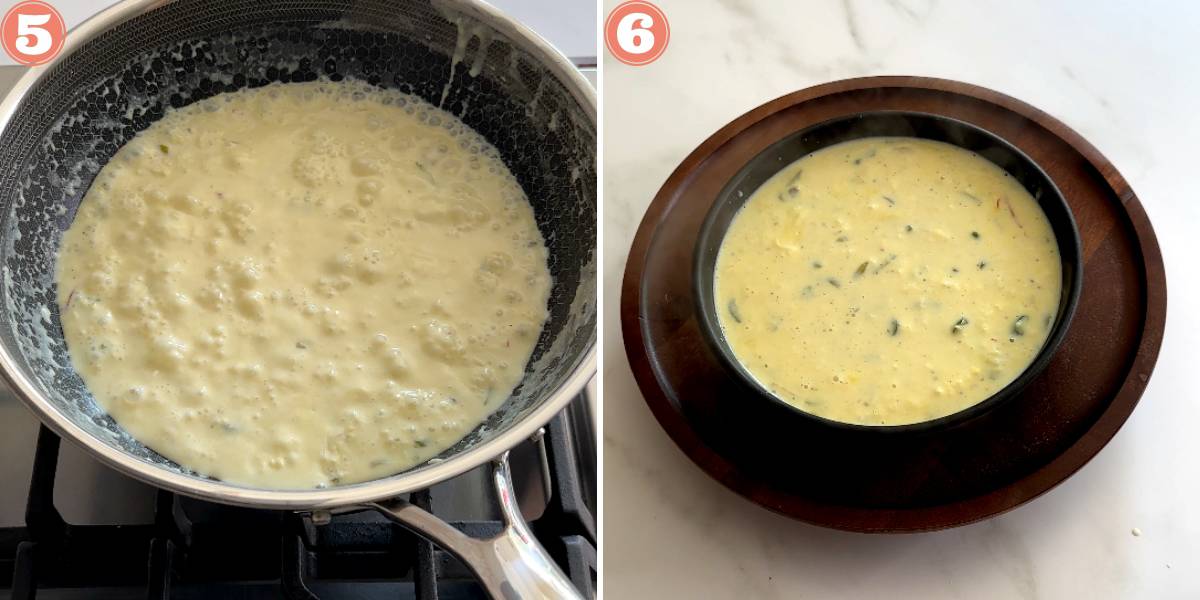
Serving Suggestions
Rabdi can be enjoyed in a variety of delightful ways. Here are some that Ive enjoyed over the years:
- Plain and Simple: Serve rabdi in small bowls and garnish with a few strands of slivered almonds or pistachios, and add a few edible rose petals for an elegant touch.
- Rabdi Parfait: Layer rabdi with crumbled or crushed cookies (like digestive biscuits or nankhatai) and repeat the layers for a delicious parfait.
- Rabdi Gulab Jamun: Warm gulab jamuns served with chilled rabdi create a rich and indulgent dessert. Garnish with chopped nuts or a sprinkle of edible rose petals for an extra touch of luxury.
- Rabdi Jalebi or Malpua: Pair rabdi with hot and crispy jalebi or malpua. The contrast between the sweet syrup-soaked jalebi (or malpua) and the creamy rabdi is a classic Indian dessert combination. You can even serve this as a mini-dessert by reducing the serving size in half and assembling it in mini cups.

How to Store & Freeze
Rabdi can be stored in an airtight container in the refrigerator for 3 to 4 days. However, its texture may become thicker as it sits in the fridge. Stir it before serving to restore its creamy consistency.
If it appears too thick, stir in a tablespoon or two of warm water or milk into the rabdi.
For longer storage, you can freeze it up to a month. To reuse, thaw it overnight in the refrigerator.
If the milk seems separated from the paneer curds on thawing, give it a good stir, or microwave it for 10-15 seconds to restore the creaminess.
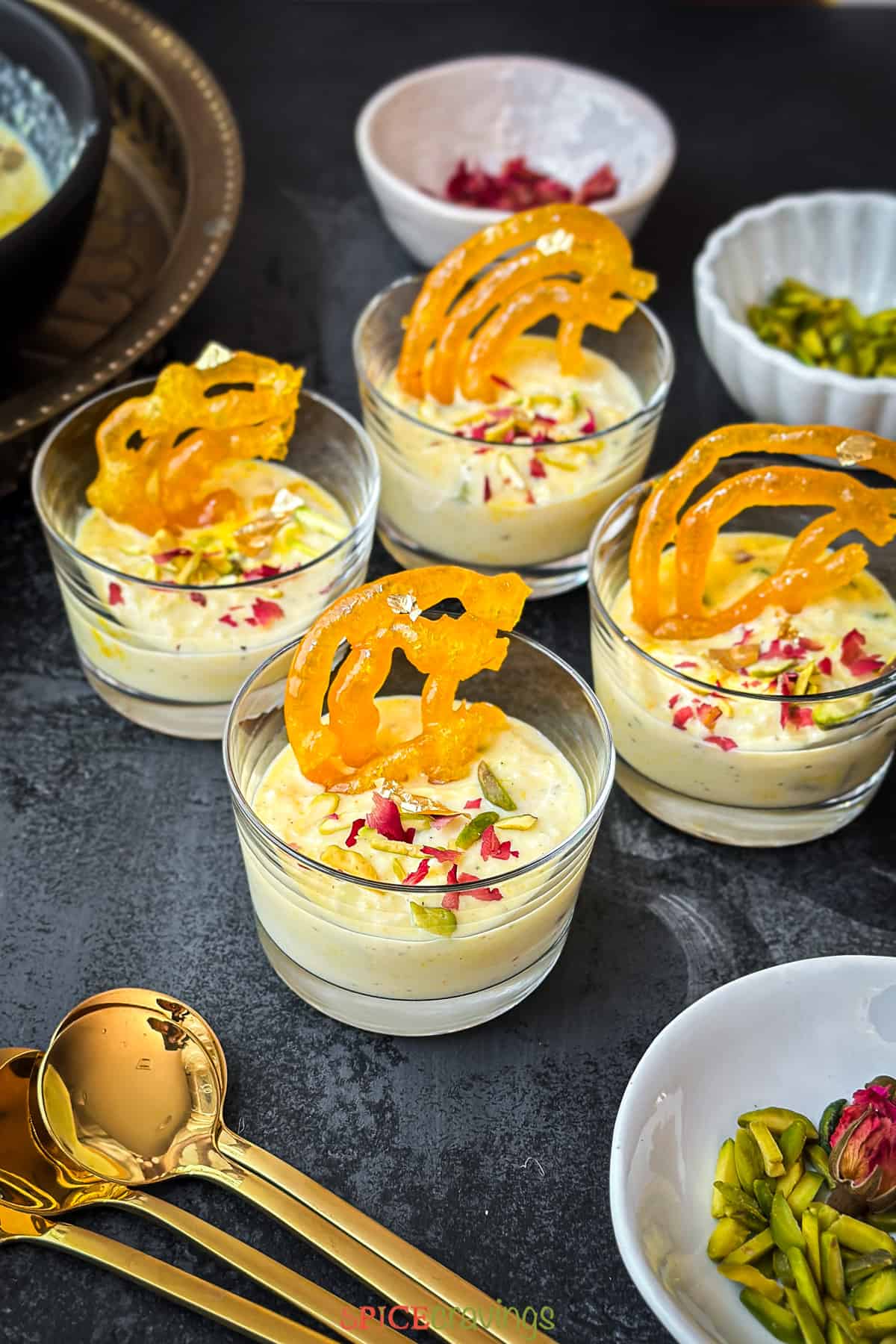
Recipe Tips & Notes
- Paneer: Use full-fat paneer for the best results. Make your paneer at home with this easy homemade paneer recipe, or use your favorite store brand.
- Milk & milk powder: Use full-fat or whole milk-based products for a rich and creamy taste. You can substitute reduced fat (2% fat) products but know that the result won't be as thick and creamy. I don't recommend fat-free paneer, milk, or milk powder in this recipe.
- Sweetness level: This recipe results in a traditional, medium-sweet rabdi. You can adjust the sweetness based on your liking. For a sweeter rabdi, add another 1 to 2 tablespoons of sweetened condensed milk. For a less sweet rabdi, reduce a tablespoon or two.
- Saffron: For the best aroma and color, it is important to soak the saffron strands in hot milk for 5 minutes. Don't skip this step.
- Nuts: Pistachios are the traditional choice for rabdi, however, feel free to use almonds or cashews instead, or skip it altogether for a nut-free dessert.
- Don't overcook: Since rabdi continues to thicken as it cools, it is important to stop the cooking process when it thickens to a heavy cream-like consistency.
- Texture Fix: If your rabdi appears too thick, stir in a tablespoon or two of warm water or milk into the rabdi. You may add a little more sweetness to balance the taste. Stir in a teaspoon of condensed milk to fix the sweetness.
Frequently Asked Questions
Rabdi is made by simmering milk on low heat until it thickens and reduces significantly, resulting in a creamy and rich pudding-like consistency.
Rabdi is often referred to as "sweet Indian milk" or "sweet thickened milk" in English.
It's a traditional Indian dessert that originates from the Northern Indian region.
More Milk-Based Indian Desserts
These recipes are part of the Indian Dessert Recipes Collection:
★ Did you make this recipe? Please give it a star rating below! For more quick & easy recipes, FOLLOW ME on Facebook, Instagram, Pinterest and Youtube.
📖 Recipe
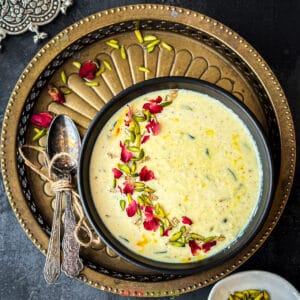
Rabdi
Ingredients
- 2 tablespoon water
- 2 cups whole milk
- 1 cup paneer, grated about 4 ounces
- ½ cup + 1 tablespoon sweetened condensed milk (½ of a 14oz can)
- 10 saffron strands
- 2 tablespoons milk powder full-fat
- ½ teaspoon cardamom powder
- ⅓ cup slivered pistachios
- 1 tablespoon dried rose petals (optional)
Instructions
- Add water: Place a deep non-stick pan and turn on the heat to medium-high. Add water to the pan. This prevents the milk from sticking to the pan.
- Boil milk: Add milk to the pan and bring it to a boil, stirring regularly while scraping the sides of the pan with a spatula.
- Soak saffron & simmer milk: When the milk reaches a boil, reduce the heat to medium. Scoop out 2 tablespoons of the warm milk and add to the saffron. Let it sit for 5 minutes for the saffron strands to release their color. Keep simmering the milk for 5 minutes, stirring every minute and scraping the sides.
- Add rabdi ingredients: Now add grated paneer, condensed milk, soaked saffron with milk, milk powder, cardamom powder, and sliced pistachio to the simmering milk, and stir well.
- Simmer to thicken: Continue to simmer the radbi mixture on medium heat until it begins to thicken, about 10 minutes. Stir and scrape the sides regularly during this time. The rabdi should resemble the consistency of heavy cream at this point- thick but still pourable. Keep in mind that it will thicken considerably as it cools, so don't overcook it.
- Chill and serve: Pour it into a serving bowl and refrigerate to chill for 4 to 6 hours. Serve it as it is, or pair it with a jalebi.
Video
Notes
- Paneer: Use full-fat paneer for the best results. Make your paneer at home with this easy homemade paneer recipe, or use your favorite store brand.
- Milk & milk powder: Use full-fat or whole milk-based products for a rich and creamy taste. You can substitute reduced fat (2% fat) products but know that the result won't be as thick and creamy. I don't recommend fat-free paneer, milk, or milk powder in this recipe.
- Sweetness level: This recipe results in a traditional, medium-sweet rabdi. You can adjust the sweetness based on your liking. For a sweeter rabdi, add another 1 to 2 tablespoons of sweetened condensed milk. For a less sweet rabdi, reduce a tablespoon or two.
- Saffron: For the best aroma and color, it is important to soak the saffron strands in hot milk for 5 minutes. Don't skip this step.
- Nuts: Pistachios are the traditional choice for rabdi, however, feel free to use almonds or cashews instead, or skip it altogether for a nut-free dessert.
- Don't overcook: Since rabdi continues to thicken as it cools, it is important to stop the cooking process when it thickens to a heavy cream-like consistency.
- Texture Fix: If your rabdi appears too thick, stir in a tablespoon or two of warm water or milk into the rabdi. You may add a little more sweetness to balance the taste. Stir in a teaspoon of condensed milk to fix the sweetness.


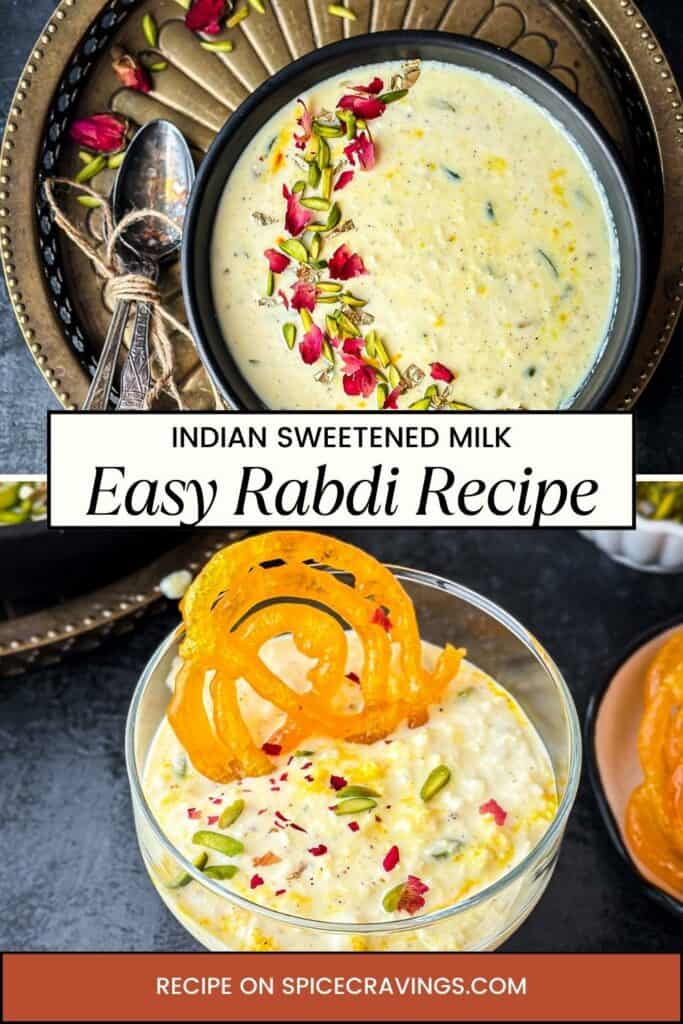
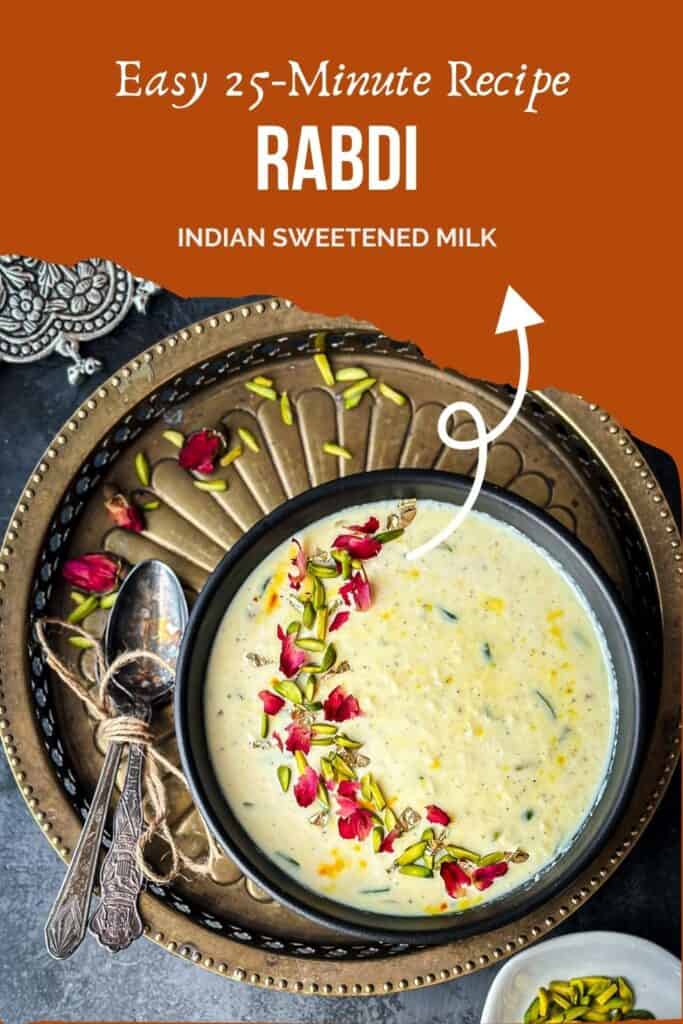

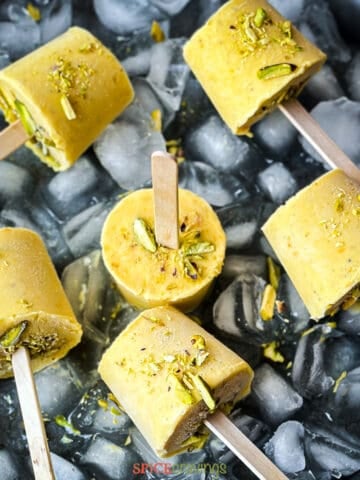
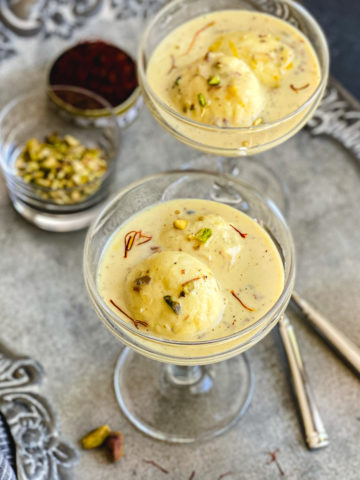
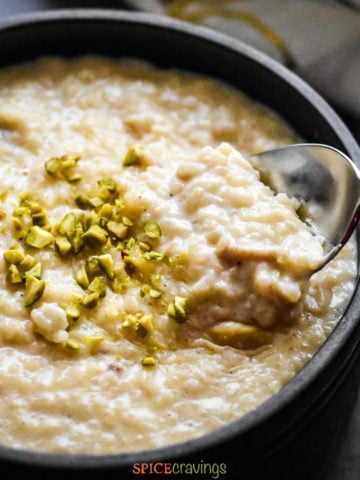
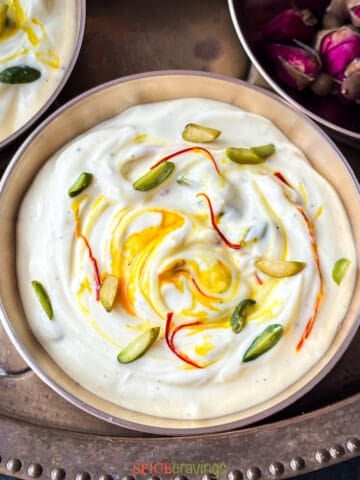
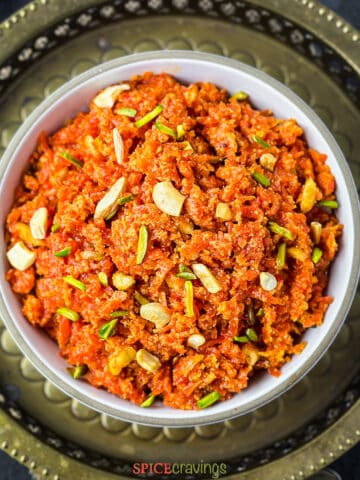
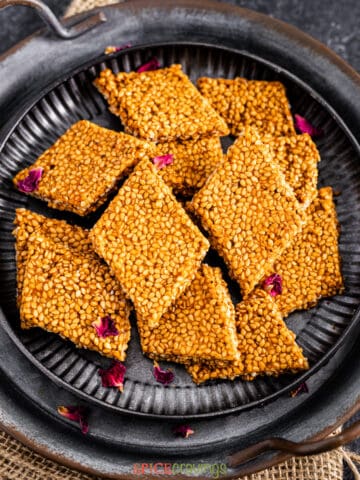
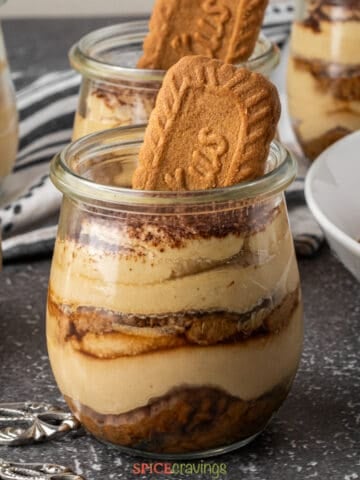

Leave a Reply